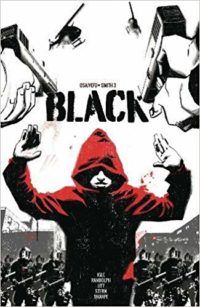5 Comics and Graphic Novels to Read if You Enjoyed THE WITCHER
I have never played any of the Witcher video games. My gaming experience came to a close with the advent of the first generation Wii; not because I don’t want to play but because I have a neurological quirk (well, one of many) that causes a delay in my brain-hands connection; the former moves markedly faster than the latter when I’m attempting to get avatars to jump or fight or not fall of a cliff. This delay, likely purely to irritate me further, doesn’t affect any other aspects of my hand eye-coordination (I can slide tackle a 3-year-old and get a flu shot in them in two seconds flat).
All this to say, well, I’ve never played any of the Witcher games. I’ve had the short story collections on my Kindle forever, but something else always need to be read first (I’ve since started the first once and am enjoying it though it is definitely early ’90s fantasy). Between the Netflix show and the book, I’ve been craving some decent fantasy and my first thought, as it often is, was to go looking for fantasy comics like Witcher. This is what I found.
 Valor by Isabelle Melançon, Megan Lavey-Heaton, Angelica Maria Lopez, Jayd Aït-Kachi, Elena “Yamino” Barbarich, et al (Fairylogue Press)
Valor by Isabelle Melançon, Megan Lavey-Heaton, Angelica Maria Lopez, Jayd Aït-Kachi, Elena “Yamino” Barbarich, et al (Fairylogue Press)
Valor is a graphic novel anthology of reimagined fairy tales. In it, digital comics artists have reset the stories to pay homage to the female heroines who are so often shunted to the side or even ignored in the most popular versions, or at least most well known. Valor is a nice mix of fractured, altered POV, and new stories and the varied writing and artistic styles, the diversity of cultures included, and a range from high fantasy to modern, horror-tinged to comedic funny, any one of these stories might have stood on their own but are even more powerful together.
Heathen Vol. 1 and 2 by Natasha Alterici and Rachel Deering (Vault Comics)
Aydis is not like other Viking women. She is not the only female warrior in her tribe but she is the only one who dares to love other women, in defiance of the law. Cast out from her home, Aydis and her trusty talking steed, Saga, ride forth on a quest to rescue Brynhild, chief among the Valkyries, from what is supposed to be an eternal prison. In Volume 2, Aydis has been separated from her friends, her horse, and Brynhild and journeys across perilous seas with a crew of pirate women, putting her life at the mercy of people-eating mermaids to find the entrance to Valhalla and confront Odin himself.
 Black by Kwanza Osajyefo, Tim Smith III, Jamal Igle, Khary Randolph, and Sarah Litt (Black Mask)
Black by Kwanza Osajyefo, Tim Smith III, Jamal Igle, Khary Randolph, and Sarah Litt (Black Mask)
This book doesn’t necessarily fit the high-fantasy mold, but it’s an important book and that high/low fantasy divide is nothing more than a construct anyway.
Kareem Jenkins and two of his friends are misidentified as robbery suspects and are gunned down by police. His friends, as expected, die from their wounds; Kareem doesn’t. Rescued from the police by a mysterious stranger, Kareem finds himself in the headquarters of The Project, where he learns that superpowers are only manifesting in black people. This, of course, can’t be allowed by the white power structure, who want to study Kareem, find the origin of his powers, and take back their firm hold on society.
Sleepless by Sarah Vaughn, Leila del Duca, and Alissa Sallah (Image)
Pypennia (Poppy) is a member of the royal family. Sir Cyranec is her guard, one of the Sleepless Knights who remain eternally vigilant in their efforts to protect the princess and the rest of the royals. When a new king is crowned, life at the palace becomes precarious and Cyranec finds his growing love for Poppy, especially in the face of her arranged marriage, and hers for him may be more of a danger than their enemies. And what will they do when Cyranec, like the elder Sleepless before him, goes mad from the punishing regime of the curse.
 The Runaway Princess by Johan Troïanowski (Random House Kids Graphic, January 2020)
The Runaway Princess by Johan Troïanowski (Random House Kids Graphic, January 2020)
You didn’t think I was going to leave the kids out, did you? The Runaway Princess was originally written in French in 2015 and is being published for the first time in translation this month. This is an adorable graphic novel about Princess Robin, who has places to go and people to see and isn’t going to let little things like rules and spooky forests get in the way of seeing the Aquatic Carnival, mountains of gold, and a city with no streets. This wonderful little book is also interactive in the vein of Herve Tullet’s Press Here and Mix it Up, which allows even the littlest of littles to become part of Robin’s story but can also grow with the kiddos as they learn to read on their own.
Fantasy is good for you, whether you favor grumpy monster hunters, self-rescuing princesses, or fantastical science with a healthy dose of social commentary. It reminds us of what what can be, challenges us to be better, and allows us to escape real-world darkness for a while. We need fantasy to survive reality; here are some lifelines.


